February 2013 LIP of the Month
The CAMP Magma Source
John H. Puffer, Dept. of Earth and Environmental Sciences, Rutgers University, Newark, NJ 07102, jpuffer@andromeda.rutgers.edu
Alan Benimoff, Dept. of Engineering Science and Physics, College of Staten Island/CUNY, Staten island, NY 10314
Introduction
Plume theory as a mechanism for generating LIPs has reached the level of general consensus among petrologists. Clearly most LIPs display all the expected physical and chemical characteristics. However there may be a few exceptions. One of the leading candidates for such distinction is the CAMP LIP. What follows, therefore, is a list of reasons why CAMP does not fit the classic plume model. We will also offer an alternative passive or non-plume proposal for the origin of CAMP that we recognize will be controversial, but hopefully thought-provoking. In addition, we will discuss environmental implications of our proposal that may have had a bearing on the mass extinction at the Triassic-Jurassic boundary. A few other petrologists to varying degrees of commitment share our plume skepticism as applied to CAMP (including McHone, 2000; Deckart, et al., 2005; De Min et al., 2003; Dorais and Tubrett, 2008; and Salters et al. 2003). However, what we will present here is a revision of perhaps the first non-plume proposal for CAMP (Puffer, 1997, 2001, and its first revision in 2003).
Geologic Setting
CAMP is one of the largest LIPs on Earth as defined by Marzoli et al. (1999) building on its initial recognition by May (1971) and subsequently further delineated by McHone (2000) and others, Fig. 1. Recent Precise 40Ar/39Ar radiometric age dating Marzoli et al. (2011) places the main phase of magmatism at 201.8 +/- 0.7 Ma. Recent and current high precision U-Pb age dating (Blackburn et al. 2012, and in prep.) indicate a very brief duration of CAMP magmatism.

Figure 1 Map of CAMP by McHone (2000).
CAMP basalts have been chemically subdivided into early and late flow and dyke populations. The earliest and most widespread CAMP population is referred to by Salters et al (2003) as the Intermediate Titanium or ITi-type that includes the Eastern North American HTQ-type. They refer to an important later type as the Low Titanium or LTi-type that includes the relatively mafic Olivine Normative or OLN-type of Eastern North America (Weigand and Ragland, 1970).
The CAMP magma source
We have compiled a list of physical, geochemical, and chronological characteristics that constrain any theory pertaining to the source of CAMP:
1. Size and shape of the CAMP – CAMP does not include some of the key features of most generally accepted plume generated igneous systems such as a hot-spot track. There are subtle ways of hiding such a track under post-plume deposition or eroding away evidence but there is currently no clear consensus of a CAMP track that we are aware of. This feature is shared by the Siberian LIP that is another candidate for a non-plume origin.
2. Plume generated uplift - Czamanske (1998) argues that the absence of evidence that the Siberian traps were preceded by the topographic uplift expected of a rising plume head is a good reason to reject the application of the plume model. At first glance the CAMP seems to have been preceded by subsidence instead of uplift. However, sediment filled grabens underlying LIPs are interpreted by Hill (1991) and Rainbird and Ernst (2001) as evidence of arching and uplift over a rising mantle plume. They found that plume induced uplift typically results in erosion producing an unconformity together with block faulting and deposition of fluvial sandstones directly underlying flood basalts and show that the effects of uplift typically occur tens of millions of years before magmatism. Each of these plume characteristics applies to the tectonic setting of CAMP. Alternatively, non-plume regional thermal uplift of continental plates is predicted by Anderson (1994) as the result of the accumulation of heat beneath an insulating lithosphere. Erosion and crustal thinning over the resulting geoid high precedes continental break-up and drifting toward relatively cool geoid lows according to King and Anderson (1995).
3. Radiating dyke pattern – Plume-head magmatism is typically intruded though the crust as a network of dykes that radiate away from the center of the plume head (May 1971; Ernst and Buchan,1997; Hill, 1991; Rainbird and Ernst, 2001). This radiating pattern was used by Wilson (1997) as strong evidence for the occurrence of a superplume under CAMP. However, McHone (2000) argued that CAMP dykes intruded as a series of linear dyke populations intruded as a progressive sequence of distinct dyke trends and compositional types, not as a single magmatic event. More recently Beutela et al. (2005) proposed a rapidly rotating stress field model controlled by movement of North America away from Africa and South America. They proposed that the orientations of the three major Eastern North American CAMP dyke populations (NW, NS, and NE-trending) were controlled by either of two scenarios: 1) The NW dykes are related to the onset of decompression melting in the rift zone between North America and Africa and that the NS and NE dykes were intruded later according to the re-orientation of the rift zones they were associated with. 2) The dyke orientations reflect a changing stress field during the final stages of rifting between North America and Africa complicated by the initiation of South America’s motion. In either case radiation away from a plume center was not the controlling factor.
4. Chemical homogeneity - Despite the huge areal extent of CAMP the initial and most widespread volcanism is remarkably homogenous. Compositional variations due to hydrothermal contamination and alteration as seen in basal zones (Puffer and Laskowich, 2012, Puffer et al 2013) and post eruptive in-situ fractionation within flow cores (Puffer and Horter, 1993; Puffer and Volkert, 2001) can be considerable. However, if post eruptive influences are filtered from the data the composition of the main ITi CAMP magma type is constrained within a very narrow range on a province –wide basis (Fig. 2b). In contrast, plume generated LIPs are chemically diverse (Fig. 2a) and are characterized by chemical trends, in time and space, away from a central plume head.
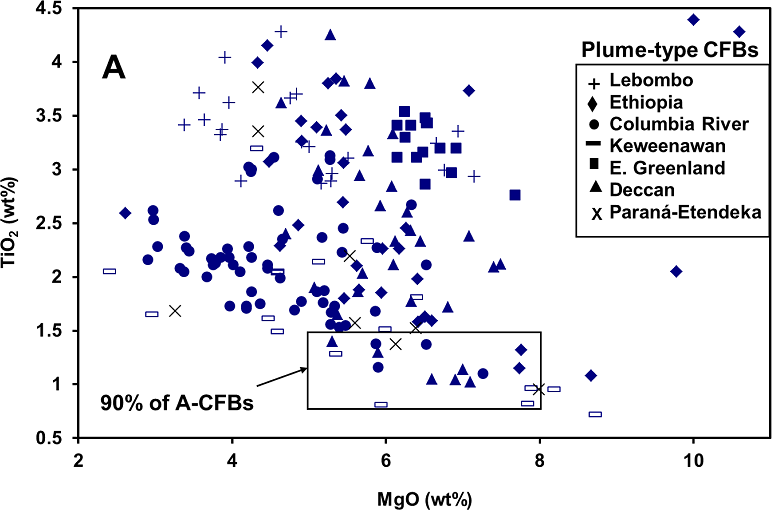
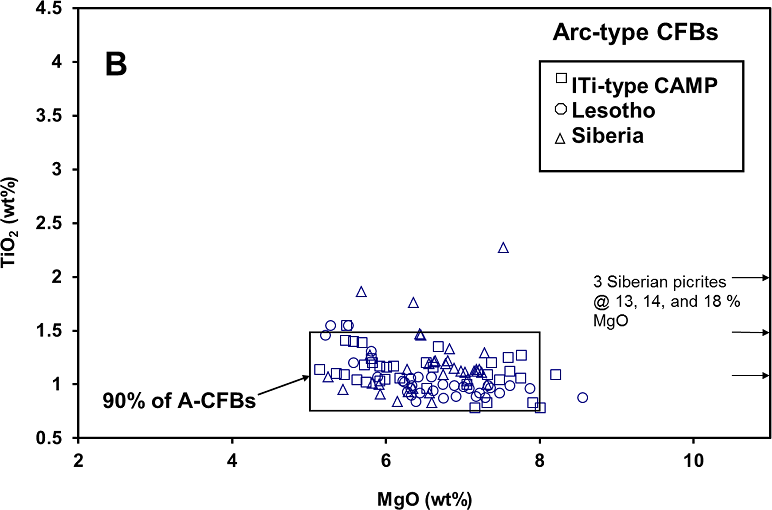
Figure 2 TiO2/MgO content of continental flood basalts after Puffer (2001) from A: probable plume generated provinces and B. provinces that contain a major subduction component and geochemically resemble arc magmatism.
It is also meaningful that CAMP is devoid of the ultramafic and ultra-alkalic rock types that are an integral part of most plume generated LIPs. Superplume LIPs in particular include a variety of such rock types as, for example, the Ontong Java Plateau (Tatsumi et al., 1998). The high temperatures and high degrees of melting required for such magma genesis are consistent with the plume model but are not available to passive processes. Instead restricted composition ranges consistent with near eutectic melting are a characteristic of CAMP.
5. Chemical composition - Plume generated LIPs are characterized by a distinctive geochemical signature that is easily distinguished from MORB or ARC magma. There may be considerable variation within plume systems, depending on size or distance from the plume head. However, in general plume generated LIPs plot on spider diagrams close to the OIB standard of Sun and McDonough (1989) that is generally accepted as typical hot-spot track ocean island basalt. Exceptions are commonly interpreted as having been mixed with varying amounts of lithosphere (Lightfoot et al. 1990, 93). Among several LIPs, mostly CFBs, average CAMP basalt shows the most deviation from OIB (Fig. 3). In particular, the strong negative Nb anomaly is generally recognized as evidence of a major lithospheric or subduction component. High degrees of mixing are not common among CFBs but are also characteristics of Siberian and Lesotho CFBs. However, the CAMP plot, including its negative Nb anomaly, more closely resembles typical island arc (Arc) as represented by typical andesite from the Andes mountains (Hickey et al., 1986) than OIB. This degree of lithospheric mixing is not predicted by the classic plume model but is consistent with some passive models. This association is true of the entire CAMP province, not just local portions, and must be an integral part of any genetic model.
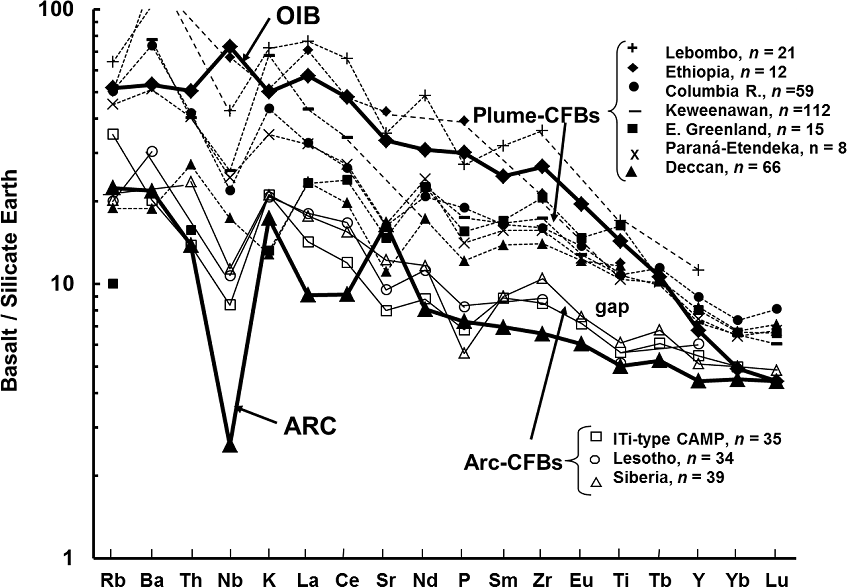
Figure 3 Sun and McDonough (1989) spider diagrams of Plume-type and Arc-type CFBs after Puffer (2001). See Puffer (2001) for sources of data. Note that ITi-CAMP more closely resembles Arc magma than any other province.
6. Mineralogical evidence - Recent evidence of subduction enrichment of CAMP is provided by mineralogical analyses. Dorais and Tubrett (2008) analyzed Cr-rich pyroxenes from ITi (HTQ) CAMP tholeiites and calculated corresponding equilibrium magma compositions with subduction enriched characteristics. They interpreted optical and LA-ICP-MS analyses of strongly zoned CPX grains as indicating that the cores are early phenocrysts not xenocrysts and were able to calculate equilibrium liquid compositions of the most primitive melt or parental magma. They found that this liquid shows incompatible element enrichment similar to Arc basalt, strongly indicating a subduction zone component in the mantle source. Their conclusions support the Puffer (2003) proposal that the parental CAMP magma bears the signature of a dormant arc mantle source trapped beneath the Pangean suture.
7. Depth of melting - As summarized by Salters et al. (2003) plume models predict that as plume heads impinge on the base of the lithosphere the initial average depth of melting is relatively deep but decreases as the degree of melting increases. They showed, however, that the initial and widespread ITi-type CAMP magma was derived from shallower depths than subsequent LTi-type) CAMP magma. Evidence that the ITi population was intruded before the largely NE trending and olivine normative LTi population includes both cross-cutting field relationships (Ragland, 1991; Ragland et al. 1983; Beutel et al. 2005) and new radiometric evidence (Blackburn et al., in-prep).
Salters et al. (2003) use La/Nb and Sr-Nd isotopic data to estimate the lithosphere/asthenospheric component in the magma after Garland et al (1996). Plume derived CFB such as the Parana show a high lithospheric content (high La/Nb) in the early stages then an increasing asthenospheric (plume) component (low La/Nb) at later stages (Garland et al, 1996) consistent with a decreasing depth of melting with time as the lithosphere is removed from the rift zone. However in the case of CAMP the data indicate just the opposite with La/Nb increasing from 8.61/6.90 in the ITi to 4.86/2.17 in the LTi. They also referred to the work of Kelemen and Holbrook (1995) who calibrated seismic velocities as a function of pressure, temperature (depth and degree of melting), and composition particularly silica and magnesium content. The data for CAMP indicate a progressive increase in the average depth of melting, directly inconsistent with a rising plume, but consistent with a passive (non-plume) break-up of Pangea.
8. Temperature of melting - Herzberg and Gazel (2009) calculated mantle potential temperatures for several LIPs including CAMP and found most melted at > 1500 oC consistent with the melting region of mantle plume heads (Fig. 4). However, CAMP was an exception and melted at < 1500oC. Our calculations using PRIMEMELT2 (Herzberg and Asimow, 2008) yield mantle potential temperatures for the mean ITi and LTi primary magma compositions (Salters et al. 2003) of 1394 ° C and 1449° C, respectively. These temperatures are lower than the melting region of the mantle plume model.
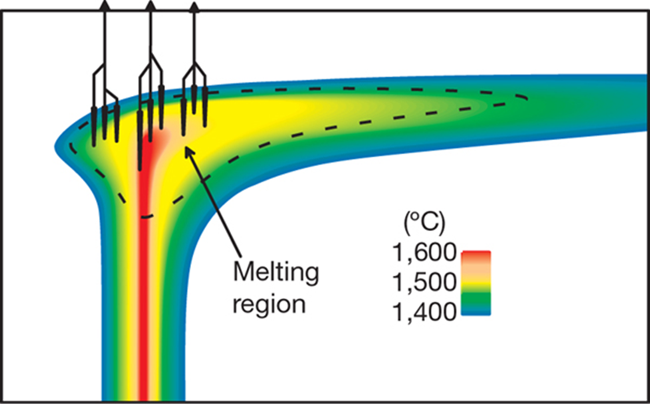
Figure 4 after Herzberg and Gazel (2009): the plume model in which hot primary magmas originate from the axis and cooler magmas originate from the periphery. The model provides an interpretation of primary magmas with highly variable compositions, inferred mantle potential temperatures and melt fractions.
9. Isotopic evidence – The Sr, Nd and Pb isotopic data of Pegram (1990) and the Sr and Nd isotopic data of Puffer (1992) were interpreted by both authors as evidence of eastern North American (CAMP) magma derivation from a subcontinental lithospheric mantle source that was enriched in a subduction component. However, important forthcoming evidence utilizing a very impressive array of new Sr, Nd, Pb, and Os isotopic data has been gathered by Renaud Merle et al. (in prep) and will have a direct bearing on a CAMP magma source.
10. Brief magmatic duration – The brief duration of the main phase of CAMP magmatism (Marzoli et al., 2011) is consistent with sudden decompression melting triggered by the initial rifting of Pangea. If the source of CAMP magma was reactivation of approximately the same source responsible for the underlying Paleozoic basaltic andesites (Puffer, 2003) a limited supply of water and other fluxes would have been available. Paleozoic subduction and arc magmatism during the assembly of Pangea would have stopped as soon as Pangea was assembled. The source of metasomatic fluxing and enrichment of the sub-continental lithospheric mantle source of CAMP would have been limited to the portion of the subducting lithospheric slab that had not already undergone Paleozoic dehydration and would have constrained the duration of CAMP magmatism.
Proposed source
CAMP magmatism was preceded and stratigraphically overlaps arc magmatism and was extruded out of rifts located close to convergent Paleozoic sutures. Figure 5 is a slightly modified version of a general model proposed by Anderson (1994).
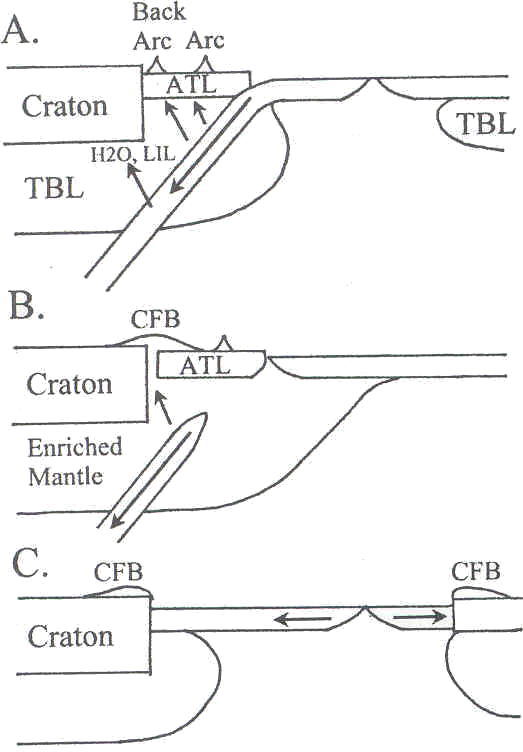
Figure 5 after Puffer (2003): A slightly modified version of a model proposed by Anderson (1994). A. The mantle wedge fluxed and enriched during subduction produces typical Arc and back arc magma. B. When the tectonic setting changes from compression to extension CFB forms as a result of plate pull-apart of the accreted terrain layer (ATL) and lithospheric delamination. C. Resumption of MORB.
A. the mantle wedge is fluxed by water and becomes enriched in LILs and generates typical Arc and Back Arc magmas but only a fraction of the available LILs ends up in the volcanics.
B. As the tectonic setting changes from compressional to extensional, continental flood basalts (CFB) form as a result of decompression melting and plate pull-apart of an accreted terrain layer (ATL), similar to the “edge-driven” model of King and Anderson (1998).
C. During seafloor spreading the shallow enriched mantle is displaced and normal depleted basalts (MORB) replace enriched CFBs.
The essential aspects of an edge-driven model involving a delamination process (Elkens-Tanton, 2005) are consistent with the facts on the ground as represented by Figure 6. A cross section through eastern North America was illustrated by Cook et al (1979) with volcanic activity added by Puffer (2003). The sequence of igneous events pertaining to the CAMP magma source begins in the early Paleozoic (Fig. 6) A. The Ammonoosuc – Piedmont Arc is developed over a subducting plate during the early Paleozoic. B. The Ammonoosuc and Piedmont are accreted onto Laurentia while a second Gondwandaland arc (Avalonia) began to migrate toward Laurentia. C. more arc-derived basalts, including the Newbury and Leighton basaltic andesites are extruded during Silurian (Acadian) accretion and subduction of an oceanic plate below the Piedmont. D. Detachment and sinking of a dense subduction slab displaces undepleted asthenosphere into a zone of enrichment above the undetached portion of the oceanic plate; a Back Arc/CFB source comparable to Fig. 5A.,B. The depth of melting of enriched mantle increases as the detached slab delaminates and creates topographic subsidence. Increasing temperatures and higher degrees of partial melting are consistent with the conclusions of Salters et al. (2003). As soon as the limited supply of water and other fluxes are depleted CAMP magmatism is terminated accounting for the brief duration of CAMP.
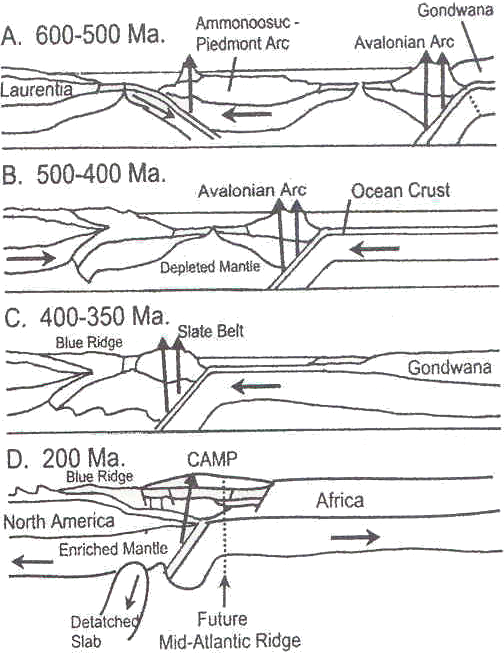
Figure 6 after Puffer (2003): A modified version of a tectonic synthesis by Cook et al (1979). A. Subduction during the early Paleozoic, B. Accretion of island arcs, C. Arc magmatism including the Newbury and Leighton Formations during accretion and subduction below the Piedmont. D. Detachment and sinking of a dense slab displacing undepleted asthenosphere into a zone of enrichment above the undetached portion of the oceanic plate. CAMP magma melts until the limited supply of flux is exhausted and penetrates through Paleozoic allochthons and through Triassic rift basins.
It is important to note that the source of the Acadian Arc volcanics and the early CAMP are virtually the same (Fig. 6) thus explaining their remarkable similarity in chemical composition to ITi-type CAMP (Fig. 7). The Paleozoic arc volcanics of Fig. 7 include the Ammonoosuc Formation (Leo, 1985), the Partridge Formation (Hollocher, 1993) and the Leighton Formation (Gates and Moench, 1981).
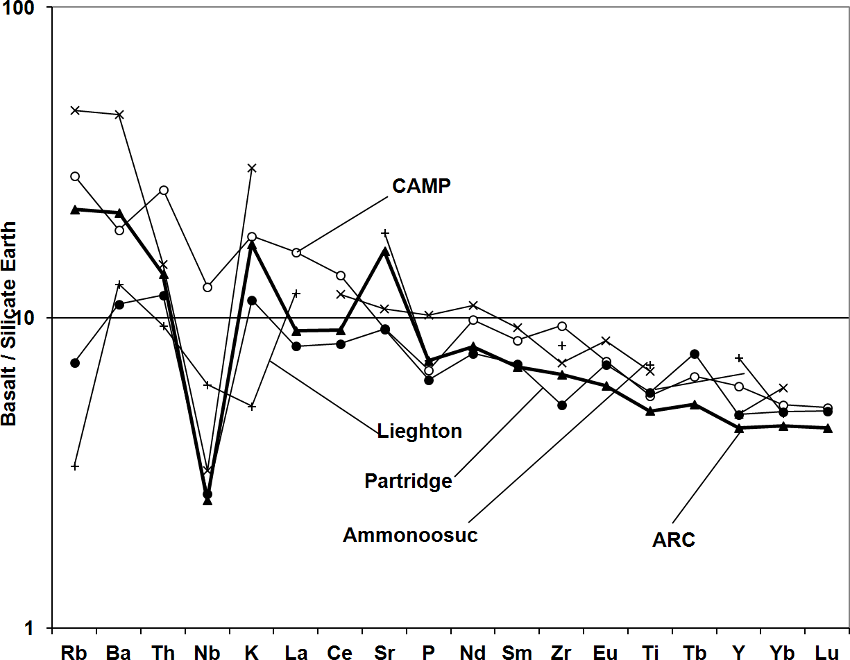
Figure 7 after Puffer (2003). Sun and McDonough (1989) spider diagrams of Paleozoic arc volcanics (Lieghton, Partridge, and Ammonoosuc) stratigraphically beneath CAMP that closely resemble both CAMP and standard Arc magmas; and may share similar source rocks. See Puffer (2003) for sources of data.
A plume, therefore, is not needed as a source of melt nor is it needed as a heat source any more than it is needed to generate MORB. After about 200 million years of thermal insulation the thick Pangean continental plate may have trapped enough heat (as described by Coltice et al., 2009) within the sub-continental lithosphere to approach solidus temperatures. If so, all that would be needed to trigger melting would be extension away from the thermally uplifted geoid center of Pangea. Gravity is the only force that could have pulled the continents apart and decompression could have triggered CAMP melting until the enriched SCLM fluxes at the magma source were depleted. CAMP was the beginning of the extensional tectonics and associated decompression melting that continues today as MORB.
Environmental Implications
It is generally recognized that arc volcanism is associated with a higher degree of sulfurous gas emission than plume volcanism. Even the residual sulfur content, contained largely within the glass phase of andesites is greater than that contained within plume generated basalts. A quick scan through the GEOROC database confirms the contrast in sulfur content. If the source of CAMP was virtually the same as the source of the underlying Acadian andesites a sudden and toxic level of sulfurous emissions probably added to the end of Triassic mass extinction.
References
Anderson, D. L., 1994, The sublithospheric mantle as a source of continental flood basalts: The case against the continental lithosphere and plume head reservoirs. Earth Plan. Sci. Let. 123:269-280.
Beutel, E.K., Nomade, S.; Fronabarger, A.K., and Renne, P.R., 2005, Pangea’s complex breakup: A new rapidly changing stress field model. Earth and Planetary Science Letters, v. 236, p. 417-485.
Blackburn, T.J., Olsen, P., Bowring S.A., Mclean, N., Kent, D., Puffer, J.H., McHone, G., and Rasbury, T., 2012, High-precision U-Pb zircon geochronological constraints on the End-Triassic mass extinction, the late Triassic Astronomical time scale and geochemical evolution of CAMP magmatism. EOS, Transactions, American Geophysical Union, Supplement Fall Meeting, San Francisco.
Blackburn, T.J., Olsen, P., Bowring S.A., Mclean, N., Kent, D., Puffer, J.H., McHone, G., Rasbury, T., and El-Touhami, M., In prep. High-precision U-Pb zircon geochronologic constraints on the End-Triassic Mass Extinction, Central Atlantic Flood Basalt volcanism and the late Triassic Astronomical Time Scale. Science.
Coffin, M.F. and Eldholm, O., 1992, Volcanism and continental break-up: a global compilation of large igneous provinces. In: B.C. Storey, T. Alabaster and R.J. Pankhurst (Editors), Magmatism and the Causes of Continental Breakup. Special Publication of the Geological Society of London, London, pp. 17-30.
Coltice, N. Bertrand, H. Rey, P. Jourdan, F. Philipps, B.R., and Ricard, Y., 2009, Global warming of the mantle beneath continents back to the Archean. Gondwana Research 15, 254-266.
Cook, J.K., Albaugh, D.S., Brown, L.D., Kaufman, S., Oliver, J.K., and Hatcher, R.D., 1979, Thin-skinned tectonics in the crystalline southern Appalachians, COCORP seismic-reflection profiling of the Blue Ridge and Piedmont. Geology, 7: 563-567.
Czamanske, G.K., Gurevitch, V., Fedorenko, V., and Simonov, O., 1998, Demise of the Siberian plume: palaeogeographic and palaeotectonic reconstruction from the prevolcanic and volcanic record, north-central Siberia. International Geology Review, 40: 95-115.
Deckart, K., Bertrand. H., and Liegeois, J.P., 2005, Geochemistry and Sr, Nd, Pb isotopic composition of the Central Atlantic Magmatic Province (CAMP) in Guyana and Guinea. Lithos, 82: 289-314.
De Min. A., Piccirilio, E.M., Marzoli, A., Bellieni, G., Renne, P.R., Ernesto, M., and Marques, L., 2003, The Central Atlantic Magmatic Province (CAMP) in Brazil: Petrology, Geochemistry, 40Ar/39Ar ages, paleomagnetism and geodynamic implications. In Hames, W.E., McHone, J.G., Renne, P.R., and Ruppel, C. (editors), The Central Atlantic Magmatic Province: Insights from fragments of Pangea, AGU Geophysical Monograph 136: 209-226.
Dorais, M.J., and Tubrett, M., 2008, Identification of a subduction zone component in the Higganum dyke, Central Atlantic Magma Province: A LA-ICPMS study of clinopyroxene with implications for flood basalt petrogenesis. Geochem. Geophysics Geosystems, 9, Q10005, 13 pp. doi:10.1029/2008GC002079.
Elkins-Tanton, L.T., 2005, Continental magmatism caused by lithospheric delamination. In: G.R. Foulger, J.H. Natland, D.C. Presnall and D.L. Anderson (Editors), Plates, Plumes and Paradigms. Special Paper. Geological Society of America, Boulder, Colorado, pp. 449-461.
Ernst, R.E., and Buchan, K.L., 1997, Giant radiating dyke swarms; their use in identifying pre-Mesozoic large igneous provinces and mantle plume, in: Mahoney, J.J., and Coffin, M.F., (Eds.) Large Igneous Provinces: Continental, Oceanic, and Planetary Flood Volcanism, Geophysical Monograph, v. 100, pp. 297-333.
Garland, F.E., Turner, S.P., and Hawkesworth, C.J., 1996, Shifts in the source of Parana basalts through time, Lithos 37: 223-243.
Gates, O., and Moench, R.H., 1981, Bimodal Silurian and Lower Devonian volcanic rock assemblage in the Machias-Eastport area, Maine, U.S. Geological Survey Prof. Paper 1184, 32 pp.
GEOROC, Geochemistry of Rocks of the Oceans and Continents. Max Planck Institute for Chemistry, Mainz, Germany. Georoc.mpch-mainz.gwdg.de
Herzberg, C., and Asimow, P.D., 2008, Petrology of some oceanic island basalts: PRIMELT2.XLSsoftware for primary magma calculation. Geochem. Geophys. Geosyst. 9, doi:10.1029/2008GC002057.
Herzberg, C., and Gazel, E., 2009, Petrological evidence for secular cooling in mantle plumes. Nature 458:619-622.
Hickey, R.L., Frey, F.A., and Gerlach, D.C., 1986, Multiple sources for basaltic arc rocks from the southern zone of the Andes: trace element and isotopic evidence for contributions form subducted oceanic crust, mantle, and continental crust. J. Geophy. Res., 91:5963-5983.
Hill, R.I., 1991, Starting plumes and continental break-up. Earth and Planetary Science Letters, v. 104, p. 398-416.
Hollocher, K., 1993, Geochemistry and origin of volcanics in the Ordovician Partridge Formation, Bronson Hill Anticlinorium, West-central Massachusetts, Amer. J. Sci., 293:671-721.
Kelemen, P.B., and Holbrook, W.S., 1995, Origin of thick, high velocity igneous crust along the US East Coast Margin, J. of Geophysical Research, 100:10,077-10,094.
King, S.D., and Anderson, D.L., 1995, An alternative mechanism of flood basalt formation. Earth and Planetary Science Letters, 136: 269-279.
King, S.D., and Anderson, D.L., 1998, Edge-driven convection. Earth and Planetary Science Letters, 160: 289-296.
Leo, R.W., 1985, Trondhjemite and metamorphosed quartz keratophyre tuff of the Ammonoosuc Volcanics (Ordovician), western New Hampshire and adjacent Vermont and Massachusetts, Geol. Soc. Amer. Bull., 96:1493-1507.
Lawver, L.A., and Müller, R.D., 1994, Iceland hotspot track. Geology, 22: 311-314.
Lightfoot, P.C. et al., 1993, Remobilization of the continental lithosphere by a mantle plume: major-, trace-element, and Sr-, Nd-, and Pb-isotopic evidence from picritic and tholeiitic lavas of the Noril'sk District, Siberian Trap, Russia. Contributions to Mineralogy and Petrology, 114: 171-188.
Lightfoot, P.C., Naldrett, A.J., Gorbachev, N.S., Doherty, W., and Fedorenko, V.A., 1990, Geochemistry of the Siberian Traps of the Noril'sk area, USSR, with implications for the relative contributions of crust and mantle to flood basalt magmatism. Contrib. Mineral. Petrol., 104: 631-644.
Marzoli, A., Renne, P.R., Piccirillo, E.M., Ernesto, M., Bellieni, G., and De Min, A. 1999, Extensive 200 million-year-old continental flood basalts of the central Atlantic magmatic province. Science 284: 616-618.
Marzoli, A., Jourdan F., Puffer J.H., Cupone, T., Tanner L. H., Weems, R.E., Bertrand H., Cirilli, S., Bellieni G., and De Min A., 2011, Timing and duration of the Central Atlantic magmatic province in the Newark and Culpeper basins, eastern U.S.A. , Lithos, v. 122, p. 175-188.
May, P.R., 1971, Pattern of Triassic-Jurassic diabase dikes around the North Atlantic in context of predrift position of the continents. Geological Society of America Bulletin, v. 82, p. 1285-1292.
McHone, J. G., 2000, Non-plume magmatism and tectonics during the opening of the central Atlantic Ocean. Tectonophysics, 316:287-296.
McHone, J.G., and Puffer, J.H., 2003, Flood basalt provinces of the Pangean Atlantic Rift: Regional extent and environmental significance: in LeTourneau, P. M. and Olsen, P. E., (editors), The Great Rift Valleys of Pangea in Eastern North America, Volume 1, Tectonics, Structure, and Volcanism: New York, Columbia University Press, Chapter 10. p. 141-154.
Renaud M., Marzoli,A., Reisberg, L., Bertrand, H., Nemchin, A., ChiaradiaM., Callegaro, S., JourdanF., Bellieni, G., Kontak D., Puffer J., and McHone G. (in press) Geochemical stratigraphy related to mantle source variations of CAMP tholeiites from Eastern North America (ENA) basins: Sr, Nd, Pb and Os isotope systematics.
Pegram, W. J., 1990, Development of continental lithospheric mantle as reflected in the chemistry of the Mesozoic Appalachian tholeiites. U.S.A. Earth Plan. Sci. Lett. 97:316-331.
Puffer, J. H., l992, Eastern North American flood basalts in the context of the incipient breakup of Pangea: in Puffer, J. H., and Ragland, P. C., (editors) Eastern North American Mesozoic Magmatism: Geological Society of America, Special Paper 268, p. 95-119.
Puffer, J.H., l997, High-Field-Strength Element Content of Continental Flood Basalts as a Basis for Determining Magma Source: Geological Society of America, Northeastern Section, King of Prussia, Penn., v. 29.
Puffer, J.H., 2001, Contrasting HFSE contents of plume sourced and reactivated arc-sourced continental flood basalts. Geology, v. 29, p. 675-678.
Puffer, J. H., 2002, A late Neoproterozoic, Eastern Laurentian superplume: location, size, chemical composition, and environmental impact. American Journal of Science, v. 302, p. 1-27.
Puffer, J. H., 2003, A reactivated back-arc source for CAMP Magma: in Hames, W. E., McHone, J. G., Renne, P. R., and Ruppel, C. (editors) The Central Atlantic Magmatic Province: Insights From Fragments of Pangea: American Geophysical Union Geophysical Monograph 136, p. 151-162.
Puffer, J. H. and Horter, D. L., l993, Origin of pegmatitic segregation veins within flood basalt: Geological Society of America Bulletin, v. 105, no. 6, p. 738-748.
Puffer, J.H., and Laskowich, C., 2012, Volcanic diapirs in the Orange Mountain flood basalt: New Jersey, USA. Journal of Volcanology and Geothermal Research, v. 237-238, p. 1-9.
Puffer J.H., and Volkert, R. A., 2001, Pegmatoid and gabbroid layers in Jurassic Preakness and Hook Mountain Basalts, Newark Basin, New Jersey: The Journal of Geology, v. 109, p. 585-601.
Ragland, P.C., 1991, Mesozoic igneous rocks, In Horton, J.W., and Zullo, V.A. (Eds.). The Geology of the Carolinas. Carolina Geological Society Fifteenth Anniversary Volume, p. 171-190.
Ragland, P.C., Hatcher, R.D., and Whittington, D., 1983, Juxtaposed Mesozoic diabase dike sets from the Carolinas; a preliminary assessment. Geology 11:394-399.
Salters, V. J., Ragland, P., Hames, W., Milla, and K., Ruppel, C., 2003, Temporal chemical variations within lowermost Jurassic tholeiitic magmas of the Central Atlantic Magmatic Province, in The Central Atlantic Magmatic Province: Insights From Fragments of Pangea, Geophys. Monogr. Ser., vol. 136, edited by W. Hames et al., pp. 163–177, AGU, Washington, D. C., doi:10.1029/136GM09.
Sun, S., and McDonough, W.F., 1989, Chemical and isotopic systematic of oceanic basalts, Implications for mantle composition and processes. In Magmatism in the Ocean Basins, edited by Saunders, A.D. and Narry, M.J., Geological Society Special Publication 42:313-345.
Tatsumi, Y., Shinjoe, H., Ishizuka, H., Sager, W. W., and Klaus A., 1998, Geochemical evidence for a mid-Cretaceous superplume. Geology. 26:151-154.
Weigand, P.W., and Ragland, P.C., 1970, Geochemistry of Mesozoic dolerite dikes form eastern North America, Contrib. to Min. Pet, 29:195-214.
Wilson, M., 1997, Thermal evolution of the central Atlantic passive margins: continental break-up above a Mesozoic super-plume. J. Geol. Soc. London 154:491–495.